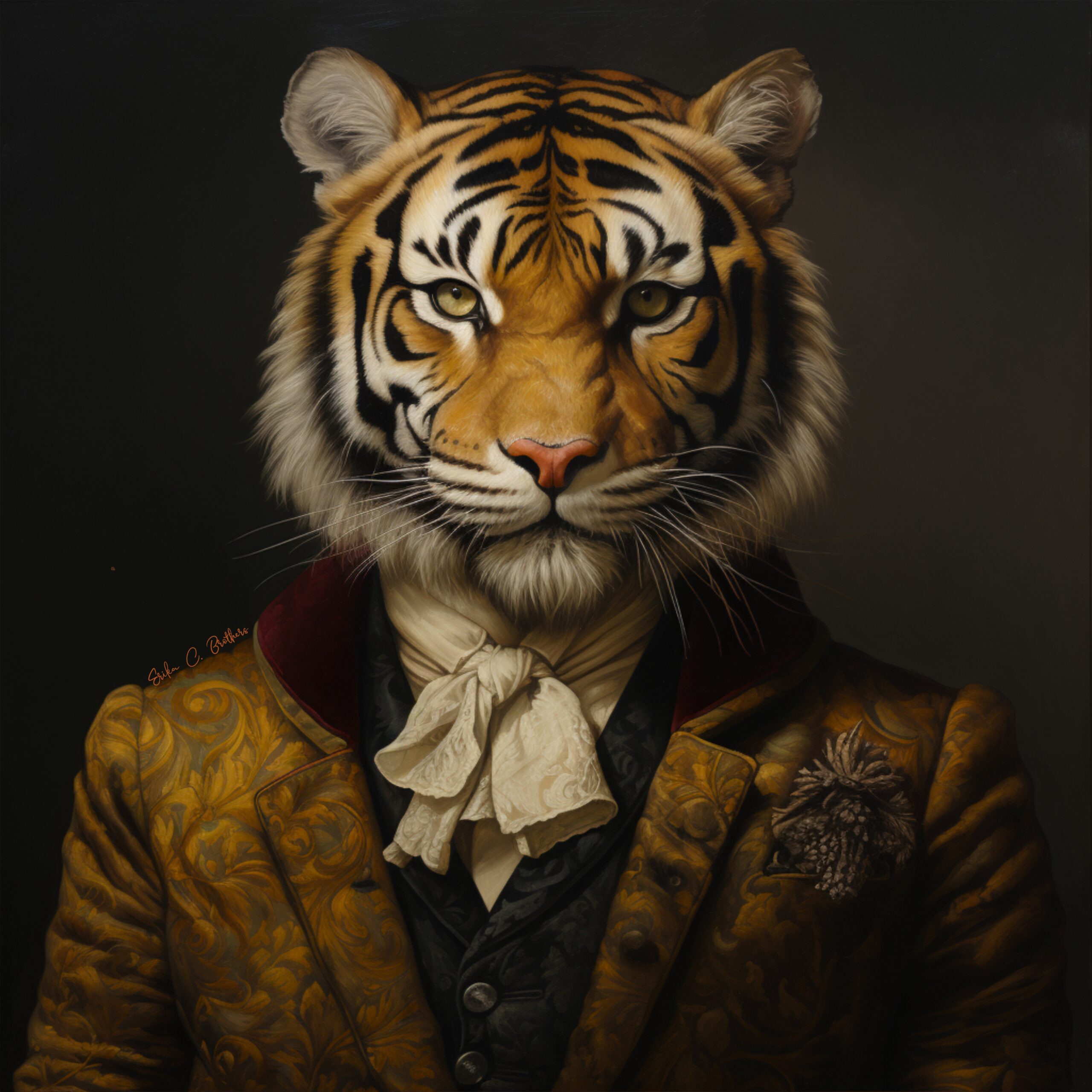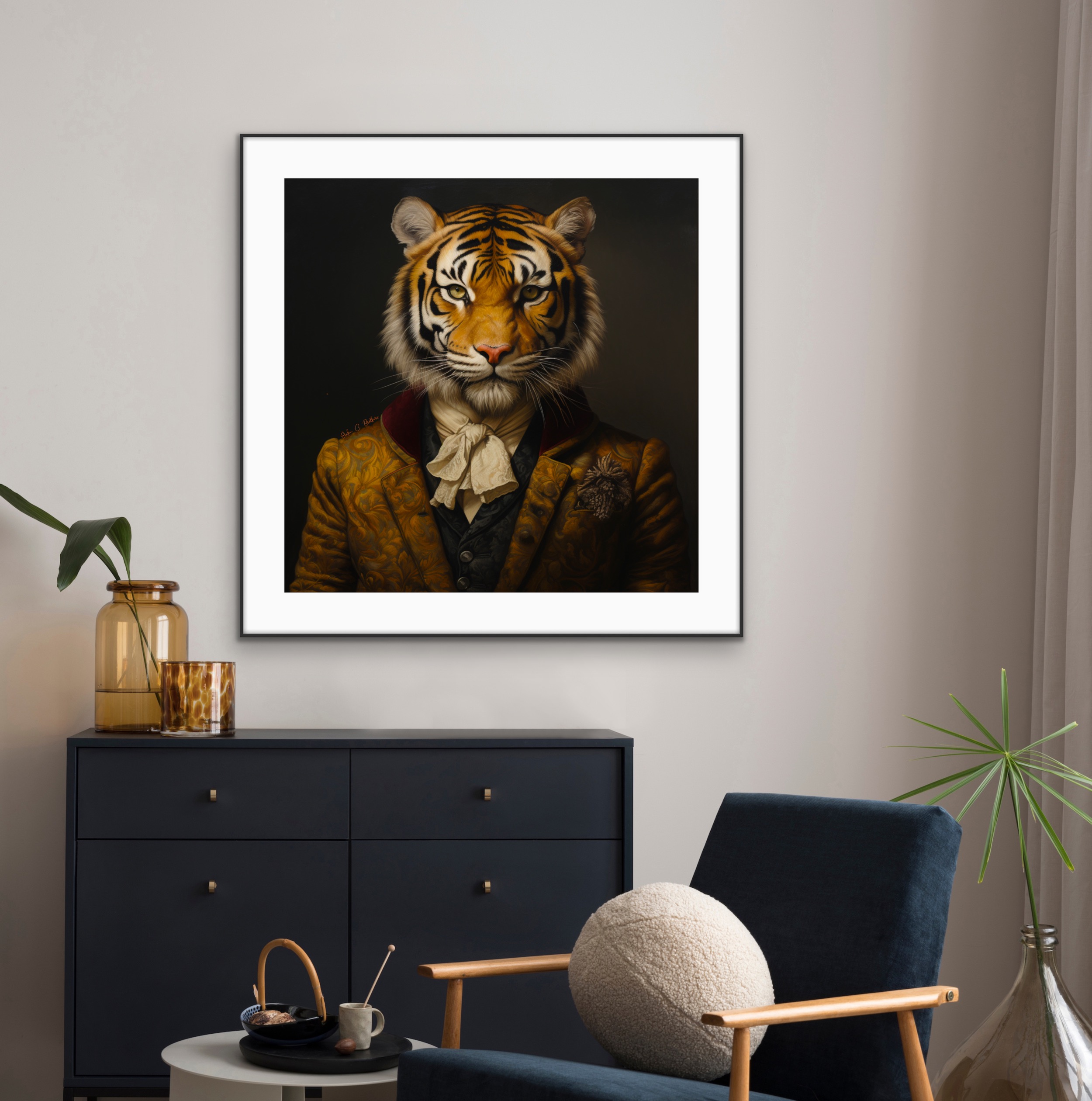Aristocrat Tiger AI Portrait
$46.00 – $883.00
Introducing my Technology AI Art category! As many know, I constantly look for new ways to create art and tell a story through visualization. Today something new for all you tech lovers and those interested in the next generation of imagination and creativity based on AI! A strange technological collaboration between AI, my thought creation, and my inner me.
Check out the new line and creations!
The Future is here, but the past will always be present
This striking image features an anthropomorphic tiger, meticulously dressed in the attire of an aristocrat, creating a powerful blend of realism and fantasy. The tiger, standing upright like a human, is depicted with remarkable detail, showcasing its majestic stripes and fierce yet composed expression. Its piercing eyes, golden and intense, gaze directly at the viewer, conveying both strength and intelligence.
The tiger is adorned in an ornate, richly textured suit, typical of the late 18th or early 19th century European aristocracy. The suit jacket is a deep golden yellow, adorned with intricate, swirling patterns that reflect wealth and sophistication. The attention to detail in the fabric’s texture adds a layer of depth to the image, making the tiger’s appearance even more regal. Underneath the jacket, the tiger wears a dark waistcoat, adding contrast to the vibrant yellow of the outerwear. A cravat, delicately tied and made of a cream-colored silk, completes the ensemble, further emphasizing the tiger’s aristocratic status.
The tiger’s posture is formal and upright, reinforcing its dignified and noble persona. The overall composition of the image suggests a portrait style often used to depict human nobility or high-ranking officials in historical paintings. This choice of style, paired with the tiger’s anthropomorphic characteristics, creates a fascinating juxtaposition that blurs the lines between human and animal, reality and fantasy.
The background of the image is kept intentionally subdued, with dark, muted tones that allow the tiger to remain the focal point. The contrast between the dark background and the tiger’s vibrant fur and clothing highlights the subject’s prominence and adds to the portrait’s overall sense of grandeur. The soft lighting subtly accentuates the tiger’s facial features and the textures of the clothing, creating a sense of depth and realism.
Symbolically, the image plays with themes of power, nobility, and the blending of human and animal traits. The tiger, a symbol of strength, courage, and wild beauty, is juxtaposed with the human-like attire of an aristocrat, which traditionally represents wealth, status, and refinement. This combination creates a commentary on the nature of power and nobility, suggesting that these qualities are not confined to humanity alone but can also be found in the natural world.
The anthropomorphism of the tiger adds a layer of intrigue and narrative to the image. It invites viewers to imagine a world where animals possess human characteristics and societal roles, challenging our perceptions of the natural order. The tiger’s composed and almost regal demeanor suggests it holds a significant position within this imagined society, perhaps as a leader or a figure of great influence.
The image also evokes a sense of timelessness. The classical style of the portrait, with its formal composition and attention to detail, contrasts with the fantastical element of a tiger dressed as a human, creating a piece that feels both rooted in history and imaginatively futuristic. This timeless quality is enhanced by the tiger’s expression, which, while fierce, also carries a hint of wisdom and contemplation, as if it is aware of its role within this imagined aristocracy.
In conclusion, this image is a masterful blend of realism and fantasy, capturing the viewer’s attention with its detailed portrayal of a tiger in aristocratic attire. The careful composition, rich textures, and symbolic elements combine to create a piece that is both visually stunning and thought-provoking. It challenges the viewer to reconsider traditional notions of power, nobility, and the relationship between humans and the natural world, all while offering a glimpse into a beautifully imagined world where these boundaries are blurred.
| FrameSize | 8×8 inches (20×20 cm), US and Mexico, 10×10 inches, US only, 11×11 inches, US only, 12×12 inches (30x30cm), US and Mexico, 16×16 inches (40×40 cm), Mexico only, 20×20 inches (50×50 cm), US and Mexico, 24×24 inches (60×60 cm), US and Mexico, 28×28 inches (70×70 cm), Mexico only, 30×30 inches, US only, 32×32 inches (80×80 cm), Mexico only, 36×36 inches (90×90 cm), Mexico only, 40×40 inches (100×100 cm), US and Mexico, 47×47 inches (120×120 cm), Mexico only |
|---|
Related products
AI ART
AI ART
AI ART











